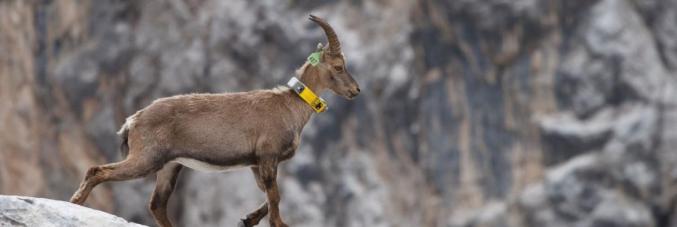
The Marmolada Mountains: climate change drives the ibex to move
17.06.2021
A study shows the effects of climate change in Alpine regions by observing the impact on movements and activity patterns of Alpine ibex (Capra ibex). The work, recently published in the international scientific journal Ecology Letter raises questions about the wild herbivores' ability to adapt to rising temperatures in the future. The work entitled, Behavioural heat-stress compensation in a cold-adapted ungulate: Forage-mediated responses to warming Alpine summers, is the result of a collaboration between the University of Padua Department of Agronomy, Food, Natural Resources, Animals and Environment (DAFNAE) and the Edmund Mach Foundation Biodiversity and Molecular Ecology Department of the Research and Innovation (DBEM).
The research, coordinated by Prof. Maurizio Ramanzin, from DAFNAE at the University of Padua, and Francesca Cagnacci of the Edmund Mach Foundation was conducted between 2010 and 2017 in the Marmolada Mountain range found in the Dolomites by observing 24 female ibexes of reproductive age. For the first time, GPS sensors were affixed to animals to identify movement, grazing, and resting activities remotely. Space-time variation, abundance, and quality of vegetation were used to direct observation protocols in the field as well as confirming the presence of kids (or billy goats) following their mother. Climatological projections were used to quantify the environmental conditions that the ibex will face in the future. Researchers were able to gather a complete picture of the ecology and behavior of a species completely dependent on environmental factors. The mode of study also provided an innovative perspective that is applicable to other species, particularly those susceptible to climate change.
Issues regarding the impact of global warming on Alpine ibex and other animals of the ungulate family are much debated in the scientific community. But thanks to the multidisciplinary research approach of this research project, it was possible to model the behavioral adaptations of the ibex in extreme environments and provide predictive elements of risks associated with the inevitable rise in temperatures linked to global warming.
Researchers also focused on the daily summer activity patterns and discovered that the Alpine ibex modifies peak hours of grazing activities according to the temperature. On the hottest of days, the animals feed mainly during sunrise and sunset, while spending midday hours resting at higher altitudes that are cooler in temperature.
Francesca Cagnacci explains, “The ibex adopts these behavioral adaptations in response to thermal stress starting at 14°C. As this particular species is most adapted to a colder climate, this number represents its threshold of thermal stress. By shifting their grazing times, females can maintain certain hours dedicated to continuous feeding. The animal’s ability to compensate for its activities was not found in other studies since GPS technology and night monitoring had not been used, only now can we hypothesis what the negative effects of thermal stress on daytime grazing activities will be. However, it remains uncertain whether this will be effective in the future. During our study, the temperatures indicated were observed only 16 days during the summer period. According to climatological projections, in a few decades, this threshold value will be exceeded to 50 days during the same summer period.”
According to climatological scenarios, analyzed by the authors, further changes in the activity patterns of the ibex are foreseeable. With a tendency to move more during the night and climbing higher altitudes.
Prof. Maurizio Ramanzin explains, “All together, these conditions raise several questions about the ability of this and other animal populations found in the mountain region of the Dolomites to adapt to rising temperatures due to climate change. The animal’s movement activities toward higher levels of elevation are limited by the typical orography of the Dolomites which are characterized by areas of poor vegetation and rocky walls found along relatively low altitudes. This area is unlike the Western Alps that offer the vast availability of high altitudes and meadows where the ibex can graze and shelter from the heat at the same time. Furthermore, the increasing exposure to days of intense heat could further shift the peaks of foraging to nighttime. In these conditions, females of reproductive age with kids in tow may struggle to move and locate much-needed resources.”
According to researchers, these broad-spectrum studies should be conducted on other animal species found in the Alps that are particularly exposed to rapid climate change, so that we may promptly identify which are most at risk.



